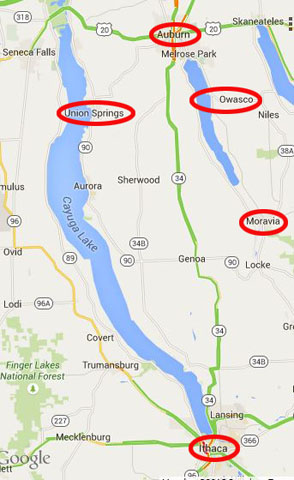
This account began as a reply to several questions a high school classmate had about my hometown of Union Springs long after he'd moved away, including whether we had wells and septic tanks. By coincidence, the answers to both intimately involved both my father and me.
This map identifies locales later mentioned for those not familiar with the area. And this account provides more information about Union Springs itself.

The fourth of nine children, my father quit school at age 14 to help support the family when his father died. By the early 1930s, he was an operating engineer (crane operator), mainly working in the area around New York City. When a contractor for whom he often worked got the job to install a water system in Union Springs in the late 30s, he came along.
He was a handsome charmer, and my mother was also quite a looker, as well as being somewhat
mischievous. We heard how she and a friend who was a kindred spirit
used to persuade Andrew Smith and his wife Ida – yes, our very
own principal and language teacher! – to drive them into Auburn so they could
see a movie! No doubt things were a lot more casual in those days. In any case, I
wouldn't be here now if they hadn't met. These are some photos from their
younger days that my sister inherited. You can see where I got my good looks!

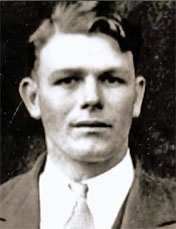 |
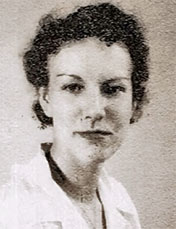 |
Some 30 years later, the town was discussing installing a sewer system, and my father was able to provide first-hand knowledge that the state was considering stricter regulations for septic tanks that might make it quite expensive to continue with them (see later). They decided to go ahead with a sewer system, and two years later, both of us were working on that project.
Recalling those times got me carried away with the following reminiscences and indented digressions. (There was also the earlier year-round job for five years or so delivering the Syracuse Herald-Journal (daily) and Herald-American (Sunday) newspaper, "through rain or sleet or snow," the latter of which we received in abundance.)
• The first summer job after I graduated from high school in 1958 is described in this remembrance of a friend who succeeded me there. It was intended for classmates, so it includes references that may be unfamiliar. In fact, I haven't even included a link to it on my Home Page.
• In 1959, the summer after my freshman year at Syracuse University, my father was able to get me a job as his oiler (described later) on a road project south of Ithaca. We worked 10 hours during the week and 8 on Saturday, and the drive was over an hour each way. The long hours left little time for socializing, not to mention that by the end of the week I was pretty pooped.
However, I really made out financially – as a union member, I got paid time-and-a-half for weekday hours over eight and double time on Saturday. That amounted to 71 hours, and at $2.50 an hour it really added up! Actually, in those days that was really good pay compared to other available jobs, and tuition, and room and board at my fraternity, were also comparatively reasonable. Along with a General Motors scholarship, I was able to pay my way through college.
• In 1960, my father wasn't able to get me an oiler's job – it went to a relative of the union rep. However, I was able to get a job with the Agriculture Department inspecting farms participating in a corn subsidy program. That job, which was really quite interesting, was thanks to a classmate's father, who was the Cayuga County Agriculture agent.
I was provided with a record of how much corn each participating farmer had previously planted and the amount of acreage they had pledged to set aside this year. I would find out from the farmer which fields were planted in corn and which ones they were setting aside from corn production. We were given large aerial photo maps, about 3 feet square, slid into a rigid frame, onto which I was to outline the areas with corn and the "diverted" areas using different colored pencils.
However, I first had to walk the fields and measure them, or at least those that weren't neatly surrounded by hedgerows that appeared on the map. And some fields were only partially planted with corn, so I'd have to measure that area. One farm took a lot of time – the corn was contour-planted in three or four strips, and I had to make half a dozen trips up and down the hill to get a good representation to draw on the map. Not that it mattered to me because I was getting paid by the hour, plus mileage.
During the fieldwork, I'd draw rough sketches of the fields and record the various distances in a notebook, so I could accurately mark them on the maps later at home. Perhaps the fact that all the activity was unsupervised could tempt the unscrupulous to pad the numbers, although I guess they could compare the output of the various workers. However, I was conscientious, accurate (supervisors would go out and double-check at least a few of the early reports), and evidently fast, because when Cayuga County had been finished, I was assigned other farms in neighboring Onondaga County, bordering the eastern shore of Owasco Lake.
I'd have the farmer point out on the map which fields he was describing, and it was surprising to me that some of them couldn't make the connection between the aerial view and the ground view they were used to. So I'd say, "Here's where we are (pointing to the map), there's the next field over there (pointing to the map and the field), and this is the next field past that (on the map) – is that the one you mean?" Several times one would say, "That isn't what that field looks like!"
The measuring was similar to the way the old surveyors did it. I had a steel tape on a reel, like this one.
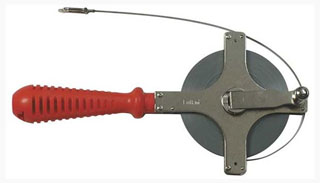
I'd clip a metal pin onto the end – it's easier to show you what they looked like than describe them
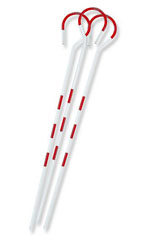
and push it into the ground at the start of the area to be measured, and walk off down the field letting the tape unreel as I went.
When I reached the end of the tape, I'd yank it out, although first I'd push in another pin where my end of the tape was. I'd slide the tape through the slot of the eye of this pin, but from now on, I'd just drag the tape behind me, adding a new pin, and pulling up the old one, until I reached the end of the area to be measured. Then I'd reel it in until it was stuck at the last pin and read the measurement on the tape. I imagine the tape was 100' because I'd count the total number of pins that had been pulled out, including the one clipped on the end, multiply by the length of the tape, and add the final tape measurement.
Of course, some of the farmers knew who I was. One questioned my knowledge of farm crops, but I assured him I could tell corn from rye! In any case, in those days everyone took a semester of Agriculture in high school, so we knew more than they might expect. After I wrote this, I wondered if it really was everyone or just every boy – I couldn't recall our class makeup – so I queried a female classmate. I found out that indeed in those days only boys took Shop and Agriculture, while girls took Home Economics. However, she said that times had changed, and her youngest daughter did take Agriculture, learning not just, for example, crop rotation and legumes but such potentially useful skills as how to oxyacetylene- and arc-weld.
Most of the farmers had relatively small farms, but there was an unusual one on the eastern shore of Owasco Lake. When I arrived at his house, the owner was overseeing the operation of a traveling boat hoist – like those at Castelli's Marina in Union Springs – bringing ashore a big yacht. He invited me in to have a Michelob draft from his bar while we discussed his holdings. In those days 18 was the legal drinking age in New York, and I was 20 by then. Obviously he was one of those people you read about that take advantage of the system meant for those that really need it.
• In 1961, the summer after my junior year, the sewer system was being installed in Union Springs, and my father was again able to get me a job as an oiler, although with someone else this time. My father had been influential in convincing people to vote for, that is, pay for, the project, telling them of the situation being faced by homeowners in the area where we had worked two summers before. As a favor to someone, we had dug up his yard for a new septic system because new regulations required larger septic fields and perhaps other additions as well.
It must have been déjà vu for my father to once again be digging up the streets of Union Springs! After the excavation in Union Springs was completed, we (this time with my father) spent the rest of the summer in a gravel pit outside Auburn loading trucks for a different project, but with the same contractor. The main thing I remember about that time was how hot and dusty it was. At the end of a school year, I was ready to give my brain a rest for the summer, but by the end of summer, I was always glad to swap physical effort for mental.1
However, the memory that I still recall from that summer was when we were digging a trench down Cayuga Street near Palmer's Chevrolet dealership. I was in the driver's seat of the truck crane, waiting until it was time to move forward for the next bites. (I had a Chauffeur's License of a class that allowed me to drive such heavy machinery, although I never took a test.) My mother told me she happened to be leaving the post office at the same time as the wife of the vice-principal, who saw me there, and reassured her that it was good that I had a job that I could fall back on!
• The next year, 1962, I had graduated from Syracuse University but needed a summer job before leaving for graduate school. Fortunately, the student job placement office was helpful, having a posting from a consulting engineering firm in Rochester that was looking for engineering students. They had been contracted to survey the city to determine what buildings had spaces that would be suitable for (shades of the Cold War) fallout shelters! There were about a dozen of us between various years of school. As the only graduate, I received the highest pay, $3 per hour. They had rented a large room in adjacent unused office space and furnished it with unfinished doors on sawhorses for tables and folding chairs, although they were cushioned. The tables were occasionally used for lunchtime naps after a late-night's activities.
For the first week, we were taught from a thick manual about the various types of construction materials and techniques and radiation transfer calculations. The Rochester city government provided detailed blueprints of all the buildings in the city, so the leader could determine likely candidates for us to check. We fanned out over the city, in pairs, with suitable government IDs and pre-printed forms on which to enter the pertinent data. I don't recall if we had to sketch the sites, but I'm pretty sure we didn't have to measure them – probably the blueprints were adequate for that. Back in the office, we entered the data and performed pertinent calculations for eventual submission to the government of those that met the criteria.
It was fascinating to view the underpinnings of a modern city, but the only site we examined that sticks in my mind is the Genesee Brewery. They were glad to show us their whole operation and the entire brewing process, although we weren't offered samples.
The Genesee Brewery indeed had enough space for hundreds, or perhaps many more, and their underground location was perfect for a fallout shelter. However the 58° degree temperature required by the brewing tanks might eventually have caused some discomfort.
After we completed the survey, they kept me on for few more weeks until I had to leave for school. They were planning a divided highway in southern New York and needed to determine the most efficient way to dispose of the earth that needed to be excavated for its construction. They had produced cross-sectional diagrams of the completed divided highway's lanes and the land between and for some distance on each side, showing its relation to the existing topography at regular intervals.
Earth that was above the desired level would have to be removed (cut) while space below would have to be filled (as you might expect, fill). The first step in determining the volume of earth involved was to measure the area of cut and fill at each cross section. This was my job, accomplished by tracing around each area with an ingenious device called a planimeter. Not very exciting, probably because I was again overqualified, but certainly an easy way to earn my pay!
I don't know how widespread was the fallout shelter survey work we were doing. I'm sure it wasn't being performed in Syracuse or I would have applied there. Perhaps ours was a trial run before a full-scale rollout, as was the Labor Department survey in Syracuse. This is really the end of the story of my summer jobs, however ...
1 These were the days long before SPF 50 recommendations, and I
endeavored to become as brown as possible, without burning, of course. Fast
forward 50 years – one day, I noticed a soft lump on my left forearm, about
1" by ½". I don't know how long it had been there; I guess I don't pay much
attention to myself –
except when someone else brings it to my attention.

My primary care physician recommended I see a dermatologist. Betty Lou has seen one monthly for several years to receive dozens of shots in her head to prevent her from going bald from an autoimmune disease. However, his website said he was not accepting new patients. We didn't think to ask, but when we did later, he said of course he'd see me. But I'm getting ahead of myself.
The dermatologist she recommended, Dr. Amir Bajoghli, was highly qualified. He removed the lump and later notified me that it was a squamous cell carcinoma. This is the second most common type of skin cancer, after basal cell, and isn't dangerous unless it gets into deeper layers of the skin.
So I returned for a Mohs procedure, which removes all of the cancer cells while sparing as much normal tissue as possible. You can see from his website that he is an expert in this procedure, and today the only way I can tell where it was is by feeling a slight indentation.
However, my experiences in his office were so strange that I wrote an account of them to my primary care physician at the time. However, I had no reason to suspect anything but a dysfunctional, certainly unprofessional, office operation. So you can imagine my surprise to hear his name mentioned on the morning news, referring to this!
It's hard for me to imagine what drove him to this, except greed. By coincidence, another doctor I've been seeing, also of Middle Eastern descent, had been approached by him at a conference to join his practice, saying he'd make him a millionaire! He was appalled and had a bad feeling about him ever since.
I guess there's no way to know if I really needed a Mohs procedure – whether I was one of those "intentionally misdiagnosed with skin cancer." Fortunately, I found out about this a week before a scheduled examination, which I was able to replace with an appointment with Betty Lou's dermatologist.2
Amazingly enough, Bajoghli is still practicing, nearly a year after his indictment! But then, I guess one is presumed innocent, etc, and probably most people don't think to investigate whether a doctor they're seeing has been accused of felonies. I checked the status of the case and found that an appeals court had recently reversed a lower court's decision regarding his attempt to make various types of evidence declared inadmissible. The wheels of justice grind slowly.
2 He initiated whole-body exams semi-annually, which was fortuitous when a year or so later a malignant melanoma had appeared on my upper back in the six months since the previous exam. Fortunately, this one also hadn't penetrated into lower skin layers, since it can be quite dangerous if it spreads.
Unfortunately, after the first excision, requiring two internal and five external stitches, the pathology test revealed that the melanoma extended to the border. The next excavation was wider and deeper, requiring three internal and seven external stitches.
Whether or not the previous lump was actually a squamous cell carcinoma, its discovery led to the more frequent exams that caught a potentially more dangerous cancer in time. At this point, I'm not even sure how carefully I'd been scrutinized during previous years' occasional physical exams.